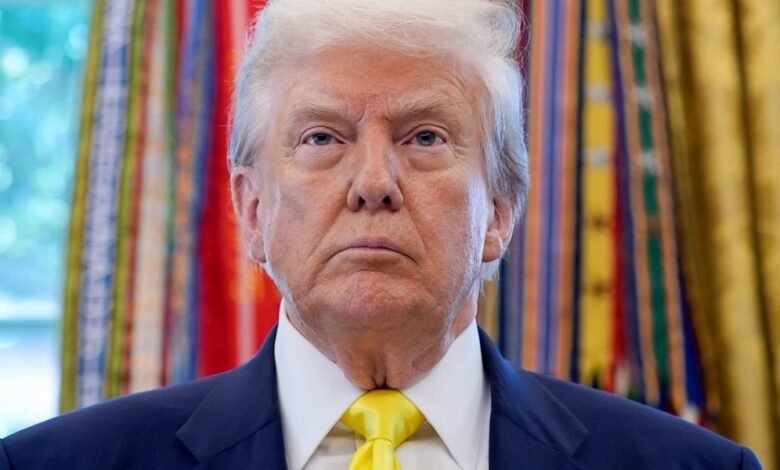Consumers are already paying two-thirds of tariff costs, says Goldman Sachs

When President Trump announced his tariff agenda, he said it would be foreign companies and consumers that would “eat” the price hikes. That’s a take which may be proved optimistic at best, and misguided at worst.
While tariffs have yet to significantly shift the dial on inflation—prompting individuals like Treasury Secretary Scott Bessent to label them the “dog that didn’t bark”—analysts are widely expecting the hikes to ultimately be paid for by the U.S.
So far the sharpest end of the tariff regime has yet to be felt. President Trump delayed his ‘Liberation Day’ tariffs by three months in order to agree deals with trading partners.
Some negotiations have proved successful, with framework deals done with the U.K., the E.U. and Japan to name a few, drastically lowering tariff rates from Trump’s initial threats back in April. Yet countries which haven’t yet agreed to a deal (who received letters informing them of their new tariff rate) saw their effective export rate rise on the deadline of August 7.
That includes nations like India, which is facing a rate of 25% that may double on August 27 as punishment for buying Russian oil. Likewise, while the Trump administration has touted a deal near-done with China on many occasions, nothing beyond an agreement to delay tit-for-tat price increases until this week has been confirmed.
With a slew of tariffs now effectively in place, Goldman Sachs believes that the cost absorbed by foreign exporters will grow over time, but will remain low.
Economist Elsie Peng wrote in a note yesterday seen by Fortune that Goldman believes exporters absorbed 14% of the costs of all tariffs in June, which will rise to 25% by October if the sanctions follow a similar trajectory to the price hikes administered by the Trump administration in his first term.
But the portion consumers can expect to pay is also on the rise. Peng noted that around 36% of the 2025 tariff costs were passed onto consumer prices after three months of implementation and around 67% were passed on after four months.
The economist added that “although the passthrough rate appears to be increasing rapidly over time, it still remains somewhat below the passthrough rate that we estimate at the same point in time during the 2018-2019 trade war.”
One portion of the economy which intends to reduce its share is U.S. businesses. The Conference Board released its U.S. CEO Confidence report for the third quarter last week, which revealed 64% are certain they’d be passing the price hike onto consumers, and a further 16% said they’re still considering.
This is a higher rate than previously identified (following the prediction of Goldman Sachs) as only in June the New York Fed reported a smaller 45% of services firms were intending to pass on the full extent of their tariff-related increases.
Peng noted that her maths “implies that U.S. businesses have absorbed more than half of the tariff costs so far but that their share would fall to less than 10%. This net impact on U.S. businesses likely masks that some companies have absorbed a larger share of tariff costs, while some domestic producers shielded from import competition have raised their own prices and benefited.”
Inflation passthrough
Of course, if consumers are paying higher prices for goods and services then the Federal Reserve’s job of keeping inflation to 2% will only get more difficult.
Goldman Sachs believes this will be the case, writing: “Our analysis implies that tariff effects have boosted the core PCE price level by 0.20% so far.
“We expect another 0.16% impact in July, followed by an additional 0.5% from August through December. This would leave core PCE inflation at 3.2% year-over-year in December, assuming that the underlying inflation trend net of tariff effects is 2.4%.”
Reflecting on the June CPI report (the latest available at the time of writing), Macquarie’s North America economists David Doyle and Chinara Azizova commented that the data was already showing hints of passthrough inflation.
They wrote last month: “Notable price pressures were apparent in household furnishings and supplies, apparel, video and audio products, sporting goods, and toys. This list suggests impacts from tariffs on the data. One measure that reflects this is core goods ex used cars and trucks. This accelerated to +0.3% MoM, its strongest pace since Feb-23. It also shows an accelerating monthly trend.”
Many economists are hoping Fed chairman Jerome Powell will see through this inflation and lower the base rate, in part to offset an alarming jobs report from the Bureau of Labor Statistics a matter of weeks ago. But analysts can’t hold their breath—after all, Powell made the point at his last press conference that by not raising rates (a move which truly would have upset markets) he is already seeing through such pressures.
https://fortune.com/img-assets/wp-content/uploads/2025/08/GettyImages-2228225642-e1754906627970.jpg?resize=1200,600
2025-08-11 10:15:40





